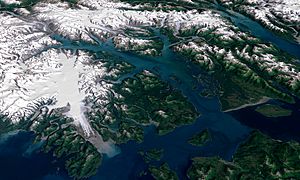Brady Glacier facts for kids

The Brady Glacier is a huge river of ice located in Glacier Bay National Park and Preserve in Alaska, USA. It stretches about 24 miles (39 kilometers) long. This amazing glacier flows south towards Taylor Bay. It is about 46 miles (74 km) northwest of a town called Hoonah.
Contents
What is Brady Glacier?
A glacier is a very large, slow-moving river of ice. The Brady Glacier starts high up in the mountains. It then slowly creeps down towards the sea. It is one of the many glaciers found in the beautiful Glacier Bay area.
How Brady Glacier Got Its Name
The Brady Glacier was named by the U.S. Coast and Geodetic Survey. This group maps the coastlines and waters of the United States. They named the glacier after Reverend John Green Brady. He was a missionary who later became a governor of Alaska. A governor is a leader of a state.
How Brady Glacier Changed Over Time
When explorer George Vancouver first saw Brady Glacier in 1794, it was a "calving tidewater glacier." This means its end reached the ocean. It would break off huge chunks of ice, called icebergs, into Taylor Bay.
A Glacier That Grew
Over the next 100 years, the Brady Glacier actually grew! It moved forward about eight kilometers (five miles). This was unusual because many other glaciers in the area were shrinking. Scientists believe this growth showed the glacier was changing. It was becoming a "non-tidal" glacier, meaning its end no longer reached the sea.
Why Brady Glacier is Special
A scientist named Bengston studied the glacier in 1962. He noted that the Brady Glacier has a very large "outwash plain." This is a flat area of sand and gravel at the glacier's end. This plain helps protect the glacier. It allows the Brady Glacier to stay strong even when others nearby are getting smaller.
The Brady Glacier also has a very low "ELA." ELA stands for "Equilibrium Line Altitude." This is the line on a glacier above which snow stays all year, even in summer. For Brady Glacier, this line is only 800 meters (about 2,600 feet) high. This is one of the lowest ELAs in all of Alaska.
Images for kids


